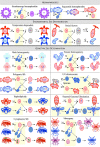Sex determination: why so many ways of doing it?
- PMID: 24983465
- PMCID: PMC4077654
- DOI: 10.1371/journal.pbio.1001899
Sex determination: why so many ways of doing it?
Abstract
Sexual reproduction is an ancient feature of life on earth, and the familiar X and Y chromosomes in humans and other model species have led to the impression that sex determination mechanisms are old and conserved. In fact, males and females are determined by diverse mechanisms that evolve rapidly in many taxa. Yet this diversity in primary sex-determining signals is coupled with conserved molecular pathways that trigger male or female development. Conflicting selection on different parts of the genome and on the two sexes may drive many of these transitions, but few systems with rapid turnover of sex determination mechanisms have been rigorously studied. Here we survey our current understanding of how and why sex determination evolves in animals and plants and identify important gaps in our knowledge that present exciting research opportunities to characterize the evolutionary forces and molecular pathways underlying the evolution of sex determination.
Conflict of interest statement
The authors have declared that no competing interests exist.
Figures





References
-
- Bell G (1982) The masterpiece of nature. Berkeley: University of California.
-
- Otto SP (2009) The evolutionary enigma of sex. Am Nat 174 Suppl 1: S1–S14. - PubMed
-
- Bull JJ (1983) Evolution of Sex Determining Mechanisms. Menlo Park, CA: Benjamin Cummings.
-
- Charlesworth B (1996) The evolution of chromosomal sex determination and dosage compensation. Curr Biol 6: 149–162. - PubMed
Publication types
MeSH terms
Grants and funding
LinkOut - more resources
Full Text Sources
Other Literature Sources

